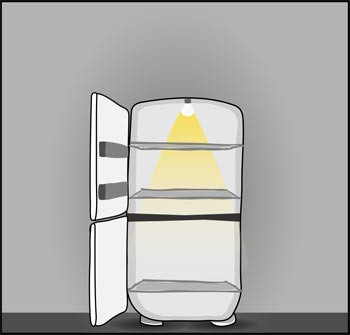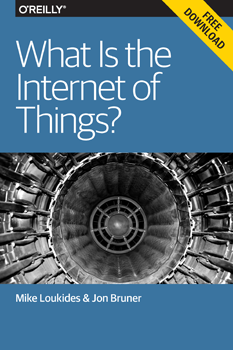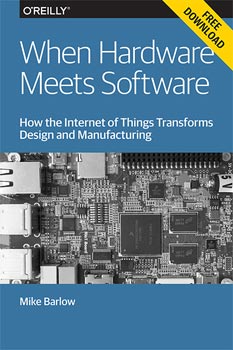"Software Intelligence in the Physical World" entries

Who should and should not be talking to your fridge?
A reflection on the social impacts of smarter hardware in the physical world.
Attend Solid 2015 to explore the IoT’s impact on privacy and security.
 Here’s the scenario today: I am out of milk, and my refrigerator sits there, mute and unsympathetic. Some time in the 90s, I was promised a fridge that would call the store when I was out of milk, and it would then be delivered while I, ignorant of my dearth of dairy, went about my business. Apparently such predictions were off. Someone forgot to tell my fridge manufacturer to put sensors, software, and networking gear into their products.
Here’s the scenario today: I am out of milk, and my refrigerator sits there, mute and unsympathetic. Some time in the 90s, I was promised a fridge that would call the store when I was out of milk, and it would then be delivered while I, ignorant of my dearth of dairy, went about my business. Apparently such predictions were off. Someone forgot to tell my fridge manufacturer to put sensors, software, and networking gear into their products.
But there is hope. The dumb objects in the analog physical world are being slowly upgraded. From the very sexy telemetry systems in new BMWs to the very unsexy pallets of lettuce in a warehouse, Things That Heretofore Were Blind and Mute are getting eyes, ears, mouths, and in some cases, brains. This is evolution, not revolution, and while it is still slow-moving, it’s beneficial to reflect on some of the social impacts of smarter hardware in the physical world. Read more…

The Internet of Things is really about software
Our new report, "What is the Internet of Things," traces the IoT's transformations and impact.
One of the reasons that it’s ubiquitous is that it bears on practically everything. A few years ago, many companies might plausibly have argued that they weren’t affected by developments in software. If you dealt in physical goods, it was hard to see how software that existed strictly in the virtual realm might touch your business.
The Internet of Things changes that; the kinds of software intelligence that have already revolutionized industries like finance and advertising are about to revolutionize all the other industries.
Mike Loukides and I have traced out our idea of the Internet of Things and its impacts in a report, “What is the Internet of Things,” that’s available for free here.
As much as we all love the romance and gratification of hardware, the Internet of Things is really about software; the hardware just links the Internet to the rest of the world. If you think of the IoT as a newly developing area in software, it’s easy to draw out some characteristics of it that are analogous to things we’ve seen in web software over the last decade or so. Read more…

Products are now platforms
With remote connectivity and remote updates, companies are able to iterate and add value to products customers already own.
Editor’s note: this is an excerpt from our recent report, When Hardware Meets Software, by Mike Barlow. The report looks into the new hardware movement, telling its story through the people who are building it. For more stories on the evolving relationship between software and hardware, download the free report.
The Internet of Things doesn’t presage a return to the world of smoke-belching factories and floors covered with sawdust. But it does signify that change is afoot for any business or activity related to the information technology or communications industries.“Not everyone will become a hardware designer,” says Joi Ito, director of the MIT Media Lab. But many students, software engineers, and entrepreneurs will see the advantages of learning how to work with hardware. “It’s never too late to learn this stuff,” says Ito, “if you decide that you want to do it.”
At minimum, software engineers should learn as much about design and manufacturing as possible. “Buy an Arduino and start building. Everything you need to learn is on the web,” urges Jordan Husney, an avid hardware hacker who serves as strategy director at Undercurrent, an organizational transformation firm and digital think tank in lower Manhattan.
In the same way that software people will have to reconfigure their modes of thinking, hardware people will need to learn new technical skills and new ways of looking at problems, says Husney. “They will have to become more comfortable with uncertainty occurring later and later in the process,” he says. “Hardware engineers will keep things in the realm of bits (as opposed to committing them to atoms) by sharing designs using digital collaboration and simulation tools virtually, while testing multiple physical prototypes. I think we’re going to see the supply chain start to shift around these concepts.” Read more…

We need an Internet that performs flawlessly, every second of every day
As we increasingly depend on connected devices, primary concerns will narrow to safety, reliability, and survivability.
Editor’s note: this interview with GE’s Bill Ruh is an excerpt from our recent report, When Hardware Meets Software, by Mike Barlow. The report looks into the new hardware movement, telling its story through the people who are building it. For more stories on the evolving relationship between software and hardware, download the free report.
More than one observer has noted that while it’s relatively easy for consumers to communicate directly with their smart devices, it’s still quite difficult for smart devices to communicate directly, or even indirectly, with each other. Bill Ruh, a vice president and corporate officer at GE, drives the company’s efforts to construct an industrial Internet that will enable devices large and small to chat freely amongst themselves, automatically and autonomously. From his perspective, the industrial Internet is a benign platform for helping the world become a quieter, calmer, and less dangerous place.“In the past, hardware existed without software. You think about the founding of GE and the invention of the light bulb — you turned it on and you turned it off. Zero lines of code. Today, we have street lighting systems with mesh networks and 20 million lines of code,” says Ruh. “Machines used to be completely mechanical. Today, they are part digital. Software is part of the hardware. That opens up huge possibilities.”
A hundred years ago, street lighting was an on-or-off affair. In the future, when a crime is committed at night, a police officer might be able to raise the intensity of the nearby street lights by tapping a smart phone app. This would create near-daylight conditions around a crime scene, and hopefully make it harder for the perpetrators to escape unseen. “Our machines are becoming much more intelligent. With software embedded in them, they’re becoming brilliant,” says Ruh. Read more…

Hardware start-ups now look a lot like software start-ups
Joi Ito on the evolution of manufacturing.
Editor’s note: this interview with Joichi Ito is an excerpt from our recent report, When Hardware Meets Software, by Mike Barlow. The report looks into the new hardware movement, telling its story through the people who are building it. For more stories on the evolving relationship between software and hardware, download the free report.
Joichi Ito is the director of the MIT Media Lab. Ito, who is also co-chair of the O’Reilly Solid Conference, recalls sending a group of MIT students to Shenzhen so they could see for themselves how manufacturing is evolving. “Once they got their heads around the processes in a deep way, they understood the huge differences between prototyping and manufacturing. Design for prototyping and design for manufacturing are fundamentally different,” says Ito. The problem in today’s world, according to Ito, is that “we have abstracted industrial design to the point where we think that we can just throw designs over a wall” and somehow they will magically reappear as finished products.The trip to Shenzhen helped the students understand the manufacturing process from start to finish. “In Shenzhen, they have a $12 phone. It’s amazing. It has no screws holding it together. It’s clearly designed to be as cheap as possible. It’s also clearly designed by someone who really understands manufacturing and understands what consumers want.”
Ito also sees a significant difference between what’s happening on the factory floors in Shenzhen and the maker movement. “We’re not talking about low-volume, DIY manufacturing,” he says. Instead, Ito’s students are working through the problems and challenges of a real, live paradigm shift — the kind of gut-wrenching upheaval described in Thomas S. Kuhn’s seminal book, The Structure of Scientific Revolutions. From Kuhn’s point of view, a paradigm shift isn’t a cause for celebration or blithe headlines — it’s a sharp and unexpected blow that topples old theories, wrecks careers, and sweeps aside entire fields of knowledge. Read more…

What you need to know for the hardware-software convergence
Core competencies and essential reading from hardware, software, manufacturing, and the IoT.
As I noted in “Physical and virtual are blurring together,” we now have hardware that acts like software, and software that’s capable of dealing with the complex subtleties of the physical world. So, what must the innovator, the creator, the executive, the researcher, and the artist do to embrace this convergence of hardware and software?
At its core, this is about a shift from discipline toward intent. Individuals and institutions — whether they’re huge enterprises, small start-ups, or nonprofits — must be competent in several disciplines that increasingly overlap, and should be prepared to solve problems by working fluidly across disciplines.
To use Joi Ito’s example, someone who wants to develop a synthetic eye might begin to approach the problem with biology, or electronics, or software, or (most likely) all three together. Many problems can be solved somewhere in a large multidimensional envelope that trades off design, mechanics, electronics, software, biology, and business models. Experts might still do the best work in each discipline, but everyone needs to know enough about all of them to know where to position a project between them.
Below you’ll find the core competencies in the intersection between software and the physical world, and our favorite books and resources for each one.
Electronics for physical-digital applications
- Practical Electronics, by John M. Hughes: To know what’s possible and where to start, it’s essential to understand both the analog and digital sides of electronics. This is O’Reilly’s authoritative introduction to both analog and digital electronics, with information on circuit design, common parts and techniques, and microcontrollers.
- Raspberry Pi Cookbook, by Simon Monk: The Raspberry Pi is rapidly becoming the standard embedded computing platform for prototyping and experimentation, with enough computing power to run familiar interpreted programming languages and widely supported operating systems.
- Arduino Cookbook, by Michael Margolis: The Arduino microcontroller offers a fluid interface between digital and physical; it’s highly extensible and accessible to people with no prior experience in either electronics or code.

Hardware is an elusive constraint on user experience
Andrew “bunnie” Huang on understanding the interplay between software, hardware, and the existing supply chain.
Editor’s note: this interview with Andrew “bunnie” Huang is an excerpt from our recent report, When Hardware Meets Software, by Mike Barlow. The report looks into the new hardware movement, telling its story through the people who are building it. For more stories on the evolving relationship between software and hardware, download the free report.
Andrew “bunnie” Huang has a Ph.D. in electrical engineering from MIT, but he is most famous for reverse engineering the Xbox, establishing his reputation as one of the world’s greatest hardware hackers. He sees an evolving relationship between hardware and software.“It used to be that products were limited solely by the capability of their hardware. Early radios, for example, had mechanical buttons that acted directly on the physics of the receiver,” says Huang. “As hardware becomes more capable, the user experience of the hardware is more dictated by the software that runs on it. Now that hardware is ridiculously capable — you basically have supercomputers in your pockets that cost next to nothing — pretty much the entire user experience of the product is dictated by the software. The hardware simply serves as an elusive constraint on the user experience.”
Hardware is “a cage,” says Huang, and good software developers learn to work within the constraints of the hardware. “When I work with programmers on new products, I take the first prototype, put it on the desk and I say, ‘Welcome to your new cage.’ That’s the reality. There’s a hard wall. But we try to build the cage big enough so there are options for programmers. A quad core Android phone with a gigabyte of memory is a pretty big cage. Sometimes when programmers feel constrained, they’re just being lazy. There’s always more than one way to skin a cat in the software world.” Read more…

Physical and virtual are blurring together
Key signals from hardware, software, manufacturing, and the Internet of Things.
![]()
This essay updates a November 2013 article. We’ve expanded it in light of the success of our first Solid conference in May 2014, where we tested many of these ideas, and the announcement of our next Solid conference in June 2015. In addition to this update, you can stay in the loop on the latest developments in the space through our weekly newsletter.
Real and virtual are crashing together. On one side is hardware that acts like software: IP-addressable, programmable with high-level procedural languages and APIs, able to be stitched into loosely coupled systems — the mashups of a new era. On the other is software that’s newly capable of dealing with the complex subtleties of the physical world — ingesting huge amounts of data, learning from it, and making decisions in real time.
The result is an entirely new medium that’s just beginning to emerge. We can see it in Ars Electronica Futurelab’s Spaxels, which are LED-equipped quadcopters that make up a drone swarm to render a three-dimensional pixel field; in Baxter, which layers emotive software onto an industrial robot so that anyone can operate it safely and efficiently; in OpenXC, which gives even hobbyist-level programmers access to the software in their cars; and in SmartThings, which ties web services to light switches.
The new medium is something broader than terms like “Internet of Things,” “Industrial Internet,” or “connected devices” suggest. It’s an entirely new discipline that’s being built by software developers, roboticists, manufacturers, hardware engineers, artists, and designers. Read more…

Saul Griffith: build soft, not solid
Soft, or compliant, robots can be safer, lighter, more efficient, and easier to control.
As we get ready to launch the 2015 version of Solid, our conference about the intersection between software and the physical world, I’ve been revisiting some lessons from Solid 2014.
For instance, Saul Griffith, founder and principal scientist at Other Lab, advises that many machines would do well to skip solidity altogether. Soft, or compliant, robots can be safer, lighter, more efficient, and easier to control. In his work with compliant robots, Griffith has managed to substitute intelligent controls for mass—replacing atoms with bits.
Watch Griffith’s entire Solid 2014 talk below. If you’d like to be notified when the Solid 2015 call for proposals goes up and when tickets become available, be sure to sign up for the O’Reilly IoT+ newsletter.
For more videos from Solid 2014, visit our Solid YouTube playlist.

